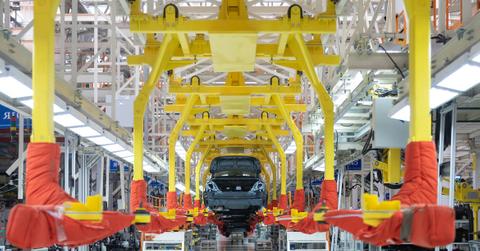Fast Funding and Bridge Loans Can Help Manufacturing Companies Bring Operations Home To Avoid Tariffs
Why fast funding is changing the game for U.S. manufacturing and how to use bridge loans to relocate operations quickly and avoid new tariffs.
May 20 2025, Published 1:45 p.m. ET

American manufacturing has always had a resilient spirit, but when the rules of the game change — like they have with today’s tariffs and global trade shifts — that resilience needs financial backup. The cost of keeping operations overseas is starting to outweigh the benefits. And if you're in manufacturing, you may be wondering how to bring things home without sinking your entire cash flow.
That’s where fast funding and bridge loans come in. They’re not about taking on long-term debt. They’re about moving quickly — before the next tariff hits or a new trade policy throws you off course.
These financial tools are giving manufacturers a way to pivot without waiting on traditional banks, which often move too slowly or require too much paperwork. Whether you’re retrofitting a facility stateside or paying the upfront cost of moving equipment out of China, this type of funding exists to bridge that gap and make sure momentum doesn’t stall. If you’ve been waiting for the right time to onshore, this might be it.
The money is available. The pressure is on. And speed might make all the difference.

Why fast funding is changing the game for U.S. manufacturing
When a manufacturing company decides to bring production back to the U.S., the decision usually isn’t made lightly. It often comes on the heels of years of dealing with unpredictable tariffs, international shipping delays, rising overseas labor costs, and customer frustration. What makes it hard isn’t the “why.” Everyone understands the risk of staying too dependent on foreign suppliers.
What’s hard is the “how.” How do you cover the cost of buying new machines, training new workers, or signing a lease on a U.S.-based facility without halting production or draining your reserves?
Fast funding can land in your account in a matter of days, and it gives you working capital exactly when you need it — not months down the road when the opportunity has passed you by. A bridge loan, in particular, works like a short-term safety net. It helps you cover large expenses now while you wait for longer-term financing or revenue from reshored operations to kick in.
Unlike traditional loans, there’s no need to go through weeks of underwriting or present a 10-year plan.

In many ways, this shift toward alternative funding isn’t just about money — it’s about survival. It’s about not losing your competitive edge just because you’re trying to do the right thing for your company and the economy. With Trump’s steel tariffs reshaping the landscape and future elections promising even more changes, there’s no time to wait for a banker to call you back.
American manufacturing is moving fast, and if you're ready to move too, the financing is out there.
How to use bridge loans to relocate operations quickly
A lot of companies think they need to sell equity or go into heavy long-term debt to afford the cost of reshoring. That’s simply not true. Bridge loans give you a different option. These are short-term, high-speed financial agreements meant to get you from one point to another without being stuck in limbo.
For example, let’s say you’ve identified a manufacturing site in Michigan and need $500,000 to retrofit it with the equipment you currently use overseas. A bridge loan can help you lock down the space, start installation, and keep things moving until the longer-term capital arrives — or until your U.S.-based orders start covering expenses.
The beauty of bridge loans is that they don’t slow down your operation. There’s no drawn-out back-and-forth or pressure to put your whole business up as collateral. In many cases, approval is based more on your revenue and projections than your credit score or existing debt. That means manufacturers with strong order books but a lack of liquidity can still take action while the window is open.
It’s not just about getting across the finish line. It’s about creating a smooth ramp to get there. When the clock is ticking and global supply chains are more unpredictable than ever, the ability to act fast — without taking on unnecessary risk — matters. That’s what makes manufacturing financing so different from other kinds of loans. It’s built for movement, not red tape.
Other smart moves for companies looking to onshore
While financing plays a big part in bringing operations back to the U.S., it’s not the only piece of the puzzle. You’ll also want to think about your supply chain relationships, your workforce pipeline, and the logistics of operating domestically. For example, if you're moving out of Asia, do you have vendors in the Midwest who can fill the same roles? If not, you may need to partner with smaller regional suppliers or invest in vertically integrating key parts of your operation.

Don’t underestimate the talent side of the equation either. Hiring in America comes with different expectations, training costs, and sometimes union negotiations. If you want your transition to go smoothly, build relationships with trade schools or local employment programs before you start the move. You may also want to explore government incentives or local tax credits designed to bring jobs back to the area. These aren’t just “nice to have” — they can make or break the economics of onshoring.
The key here is to be realistic about your timelines and flexible with your models. You might not be able to bring everything back at once. But with the right mix of bridge funding, supplier planning, and smart hiring, you can start to build a foundation that’s closer to home — and more stable for the long haul.
Avoiding new tariffs and staying ahead of policy shifts
One of the biggest reasons companies are racing to onshore now is the uncertainty in global politics. Tariffs can appear overnight. Trade agreements can fall apart with a single signature. And if you’re still relying heavily on imports, you’re putting your margins in someone else’s hands. That’s not a comfortable place to be, especially if you have investors or stakeholders who expect steady numbers.
By reshoring operations — even just partially — you take back some of that control. You can respond to customer demand faster. You can reduce your shipping costs and avoid customs headaches. And, most importantly, you can dodge the kind of financial penalties that come with overnight policy changes.
When you use fast funding and bridge loans to support that shift, you’re not just solving a temporary problem. You’re setting up your business to be stronger, leaner, and better prepared for whatever the next decade throws your way.
Bringing it home
The bottom line is this: If you're serious about manufacturing in America again, don't let cash flow slow you down. Fast funding and bridge loans are built to give you the momentum to move — not someday, but now. You don’t need to wait on banks or overhaul your entire business model. You just need to take the first step — and the money is there to meet you halfway.
